Exploring Organizational Culture and Customer Satisfaction
VerifiedAdded on 2020/05/28
|9
|1661
|70
AI Summary
The e-learning activities delve into the significance of organizational culture, highlighting how varying definitions arise from individuals' educational backgrounds. It further explores how Zappos prioritizes culture to achieve superior customer satisfaction, thereby gaining a competitive advantage in the market by fostering a large customer base that values their cultural and ethical considerations.
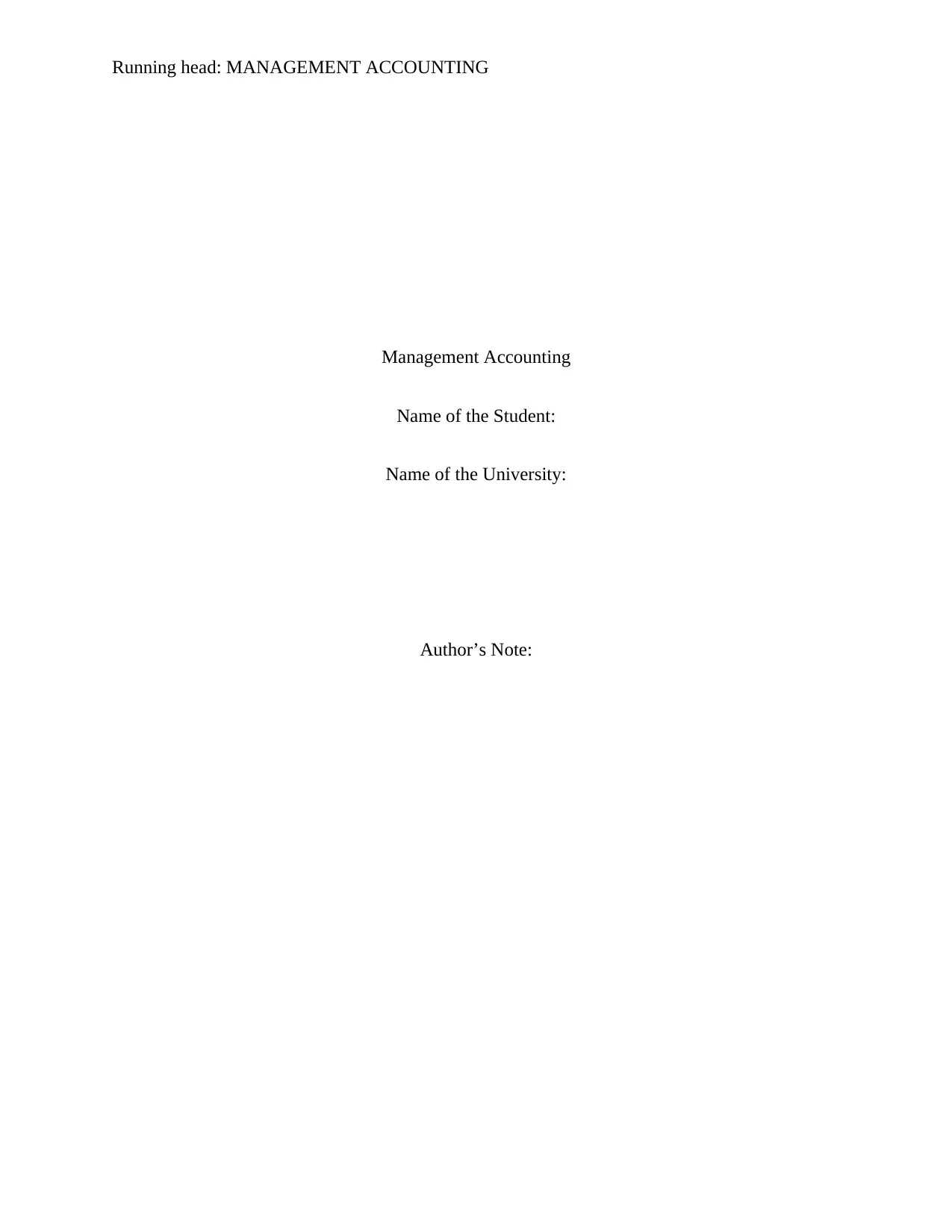
Running head: MANAGEMENT ACCOUNTING
Management Accounting
Name of the Student:
Name of the University:
Author’s Note:
Management Accounting
Name of the Student:
Name of the University:
Author’s Note:
Paraphrase This Document
Need a fresh take? Get an instant paraphrase of this document with our AI Paraphraser
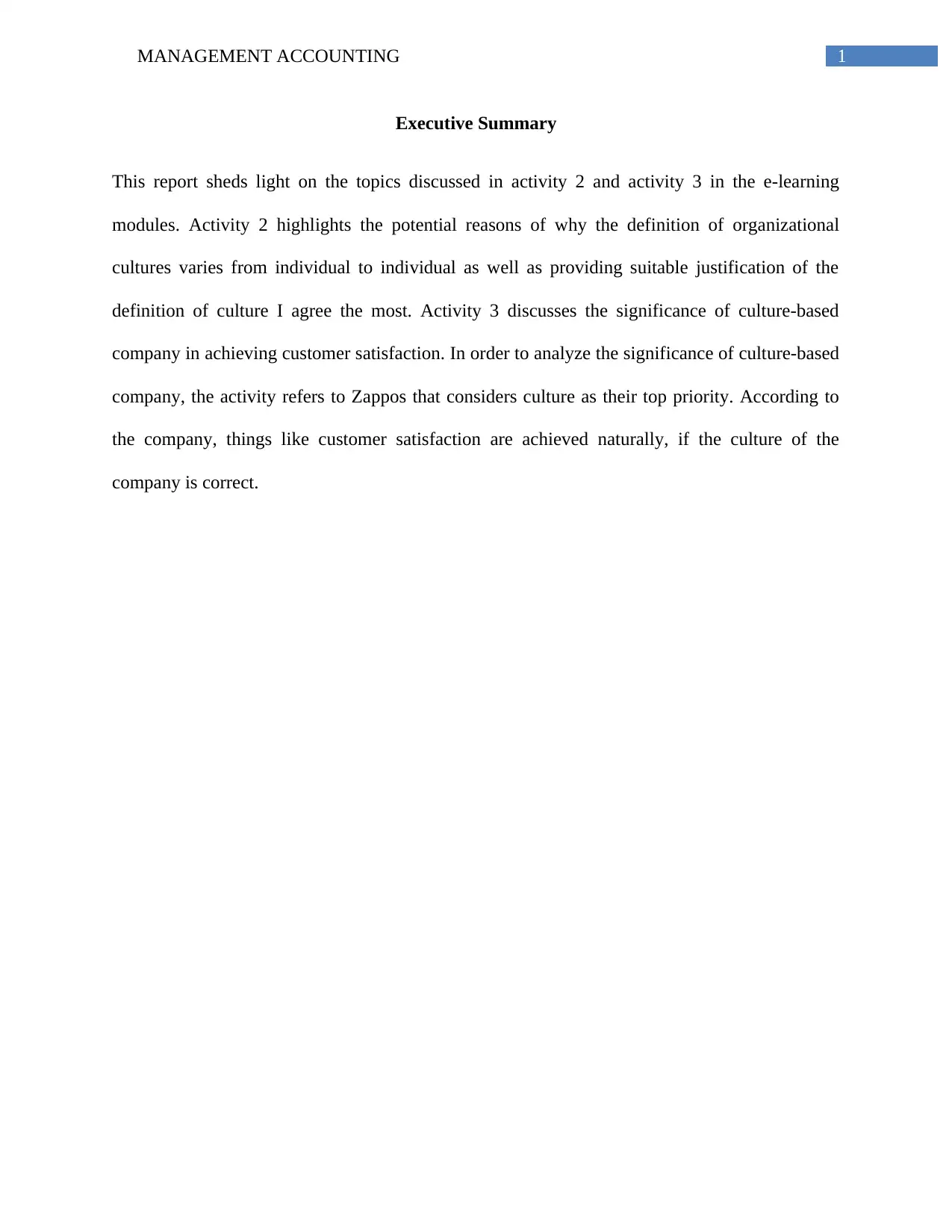
1MANAGEMENT ACCOUNTING
Executive Summary
This report sheds light on the topics discussed in activity 2 and activity 3 in the e-learning
modules. Activity 2 highlights the potential reasons of why the definition of organizational
cultures varies from individual to individual as well as providing suitable justification of the
definition of culture I agree the most. Activity 3 discusses the significance of culture-based
company in achieving customer satisfaction. In order to analyze the significance of culture-based
company, the activity refers to Zappos that considers culture as their top priority. According to
the company, things like customer satisfaction are achieved naturally, if the culture of the
company is correct.
Executive Summary
This report sheds light on the topics discussed in activity 2 and activity 3 in the e-learning
modules. Activity 2 highlights the potential reasons of why the definition of organizational
cultures varies from individual to individual as well as providing suitable justification of the
definition of culture I agree the most. Activity 3 discusses the significance of culture-based
company in achieving customer satisfaction. In order to analyze the significance of culture-based
company, the activity refers to Zappos that considers culture as their top priority. According to
the company, things like customer satisfaction are achieved naturally, if the culture of the
company is correct.
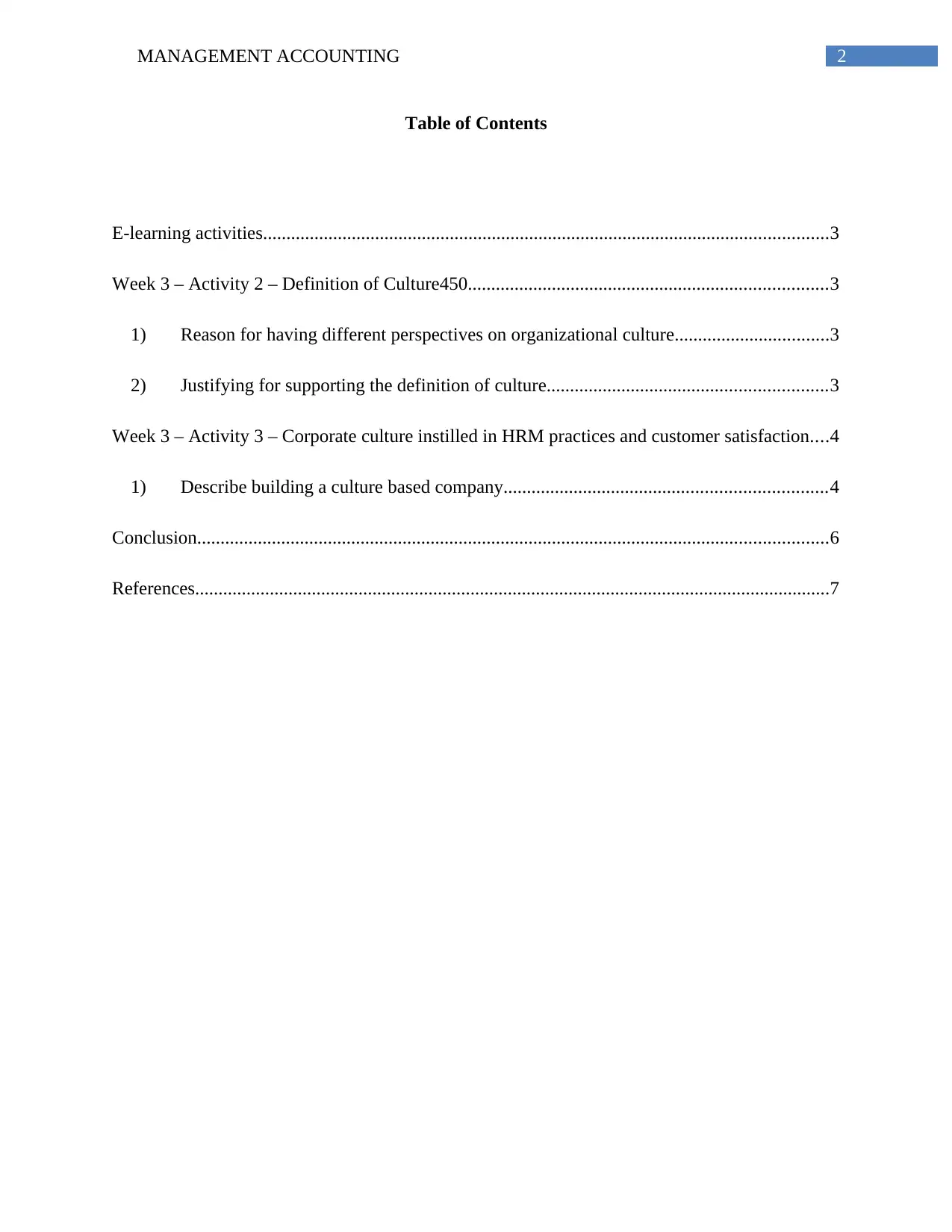
2MANAGEMENT ACCOUNTING
Table of Contents
E-learning activities.........................................................................................................................3
Week 3 – Activity 2 – Definition of Culture450.............................................................................3
1) Reason for having different perspectives on organizational culture.................................3
2) Justifying for supporting the definition of culture............................................................3
Week 3 – Activity 3 – Corporate culture instilled in HRM practices and customer satisfaction....4
1) Describe building a culture based company.....................................................................4
Conclusion.......................................................................................................................................6
References........................................................................................................................................7
Table of Contents
E-learning activities.........................................................................................................................3
Week 3 – Activity 2 – Definition of Culture450.............................................................................3
1) Reason for having different perspectives on organizational culture.................................3
2) Justifying for supporting the definition of culture............................................................3
Week 3 – Activity 3 – Corporate culture instilled in HRM practices and customer satisfaction....4
1) Describe building a culture based company.....................................................................4
Conclusion.......................................................................................................................................6
References........................................................................................................................................7
⊘ This is a preview!⊘
Do you want full access?
Subscribe today to unlock all pages.

Trusted by 1+ million students worldwide
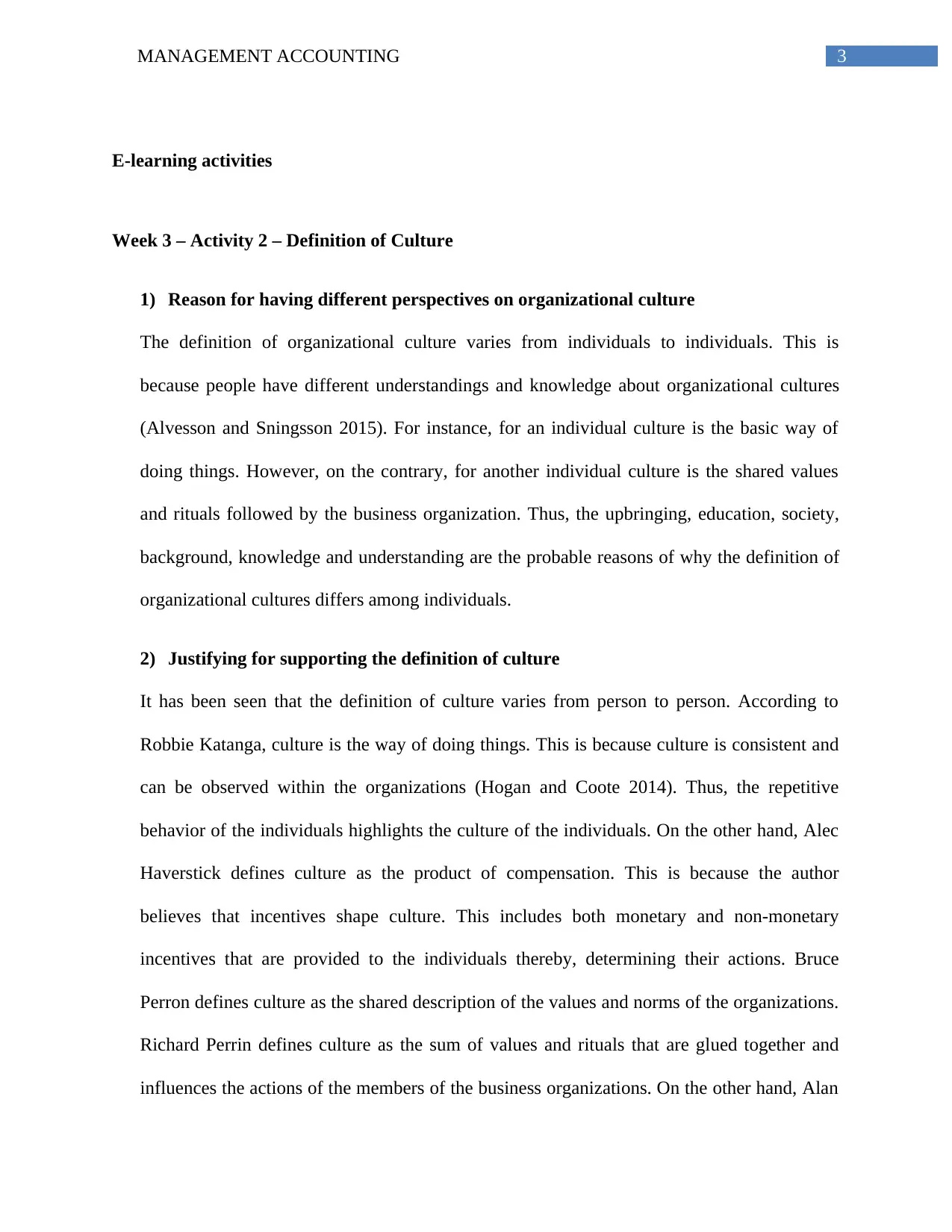
3MANAGEMENT ACCOUNTING
E-learning activities
Week 3 – Activity 2 – Definition of Culture
1) Reason for having different perspectives on organizational culture
The definition of organizational culture varies from individuals to individuals. This is
because people have different understandings and knowledge about organizational cultures
(Alvesson and Sningsson 2015). For instance, for an individual culture is the basic way of
doing things. However, on the contrary, for another individual culture is the shared values
and rituals followed by the business organization. Thus, the upbringing, education, society,
background, knowledge and understanding are the probable reasons of why the definition of
organizational cultures differs among individuals.
2) Justifying for supporting the definition of culture
It has been seen that the definition of culture varies from person to person. According to
Robbie Katanga, culture is the way of doing things. This is because culture is consistent and
can be observed within the organizations (Hogan and Coote 2014). Thus, the repetitive
behavior of the individuals highlights the culture of the individuals. On the other hand, Alec
Haverstick defines culture as the product of compensation. This is because the author
believes that incentives shape culture. This includes both monetary and non-monetary
incentives that are provided to the individuals thereby, determining their actions. Bruce
Perron defines culture as the shared description of the values and norms of the organizations.
Richard Perrin defines culture as the sum of values and rituals that are glued together and
influences the actions of the members of the business organizations. On the other hand, Alan
E-learning activities
Week 3 – Activity 2 – Definition of Culture
1) Reason for having different perspectives on organizational culture
The definition of organizational culture varies from individuals to individuals. This is
because people have different understandings and knowledge about organizational cultures
(Alvesson and Sningsson 2015). For instance, for an individual culture is the basic way of
doing things. However, on the contrary, for another individual culture is the shared values
and rituals followed by the business organization. Thus, the upbringing, education, society,
background, knowledge and understanding are the probable reasons of why the definition of
organizational cultures differs among individuals.
2) Justifying for supporting the definition of culture
It has been seen that the definition of culture varies from person to person. According to
Robbie Katanga, culture is the way of doing things. This is because culture is consistent and
can be observed within the organizations (Hogan and Coote 2014). Thus, the repetitive
behavior of the individuals highlights the culture of the individuals. On the other hand, Alec
Haverstick defines culture as the product of compensation. This is because the author
believes that incentives shape culture. This includes both monetary and non-monetary
incentives that are provided to the individuals thereby, determining their actions. Bruce
Perron defines culture as the shared description of the values and norms of the organizations.
Richard Perrin defines culture as the sum of values and rituals that are glued together and
influences the actions of the members of the business organizations. On the other hand, Alan
Paraphrase This Document
Need a fresh take? Get an instant paraphrase of this document with our AI Paraphraser
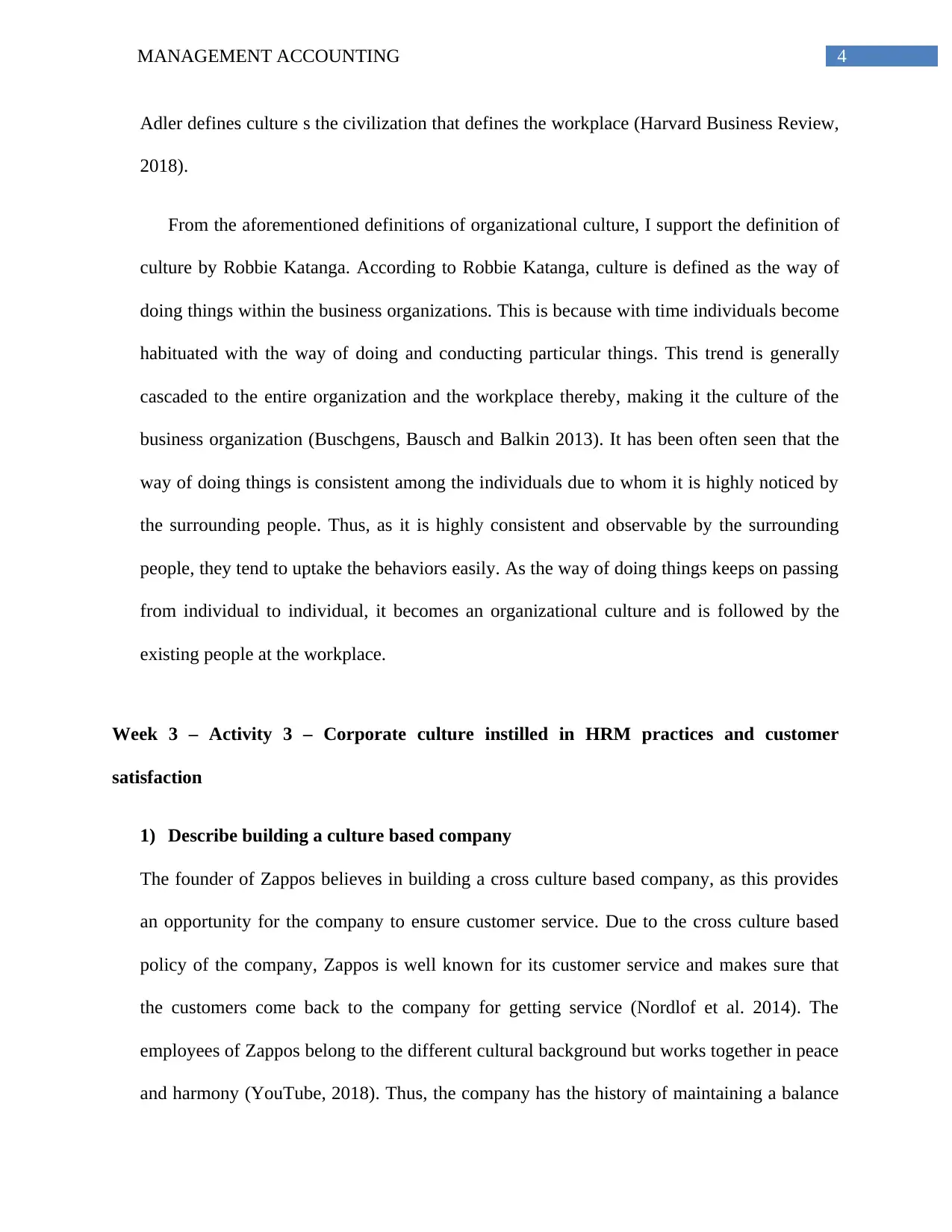
4MANAGEMENT ACCOUNTING
Adler defines culture s the civilization that defines the workplace (Harvard Business Review,
2018).
From the aforementioned definitions of organizational culture, I support the definition of
culture by Robbie Katanga. According to Robbie Katanga, culture is defined as the way of
doing things within the business organizations. This is because with time individuals become
habituated with the way of doing and conducting particular things. This trend is generally
cascaded to the entire organization and the workplace thereby, making it the culture of the
business organization (Buschgens, Bausch and Balkin 2013). It has been often seen that the
way of doing things is consistent among the individuals due to whom it is highly noticed by
the surrounding people. Thus, as it is highly consistent and observable by the surrounding
people, they tend to uptake the behaviors easily. As the way of doing things keeps on passing
from individual to individual, it becomes an organizational culture and is followed by the
existing people at the workplace.
Week 3 – Activity 3 – Corporate culture instilled in HRM practices and customer
satisfaction
1) Describe building a culture based company
The founder of Zappos believes in building a cross culture based company, as this provides
an opportunity for the company to ensure customer service. Due to the cross culture based
policy of the company, Zappos is well known for its customer service and makes sure that
the customers come back to the company for getting service (Nordlof et al. 2014). The
employees of Zappos belong to the different cultural background but works together in peace
and harmony (YouTube, 2018). Thus, the company has the history of maintaining a balance
Adler defines culture s the civilization that defines the workplace (Harvard Business Review,
2018).
From the aforementioned definitions of organizational culture, I support the definition of
culture by Robbie Katanga. According to Robbie Katanga, culture is defined as the way of
doing things within the business organizations. This is because with time individuals become
habituated with the way of doing and conducting particular things. This trend is generally
cascaded to the entire organization and the workplace thereby, making it the culture of the
business organization (Buschgens, Bausch and Balkin 2013). It has been often seen that the
way of doing things is consistent among the individuals due to whom it is highly noticed by
the surrounding people. Thus, as it is highly consistent and observable by the surrounding
people, they tend to uptake the behaviors easily. As the way of doing things keeps on passing
from individual to individual, it becomes an organizational culture and is followed by the
existing people at the workplace.
Week 3 – Activity 3 – Corporate culture instilled in HRM practices and customer
satisfaction
1) Describe building a culture based company
The founder of Zappos believes in building a cross culture based company, as this provides
an opportunity for the company to ensure customer service. Due to the cross culture based
policy of the company, Zappos is well known for its customer service and makes sure that
the customers come back to the company for getting service (Nordlof et al. 2014). The
employees of Zappos belong to the different cultural background but works together in peace
and harmony (YouTube, 2018). Thus, the company has the history of maintaining a balance
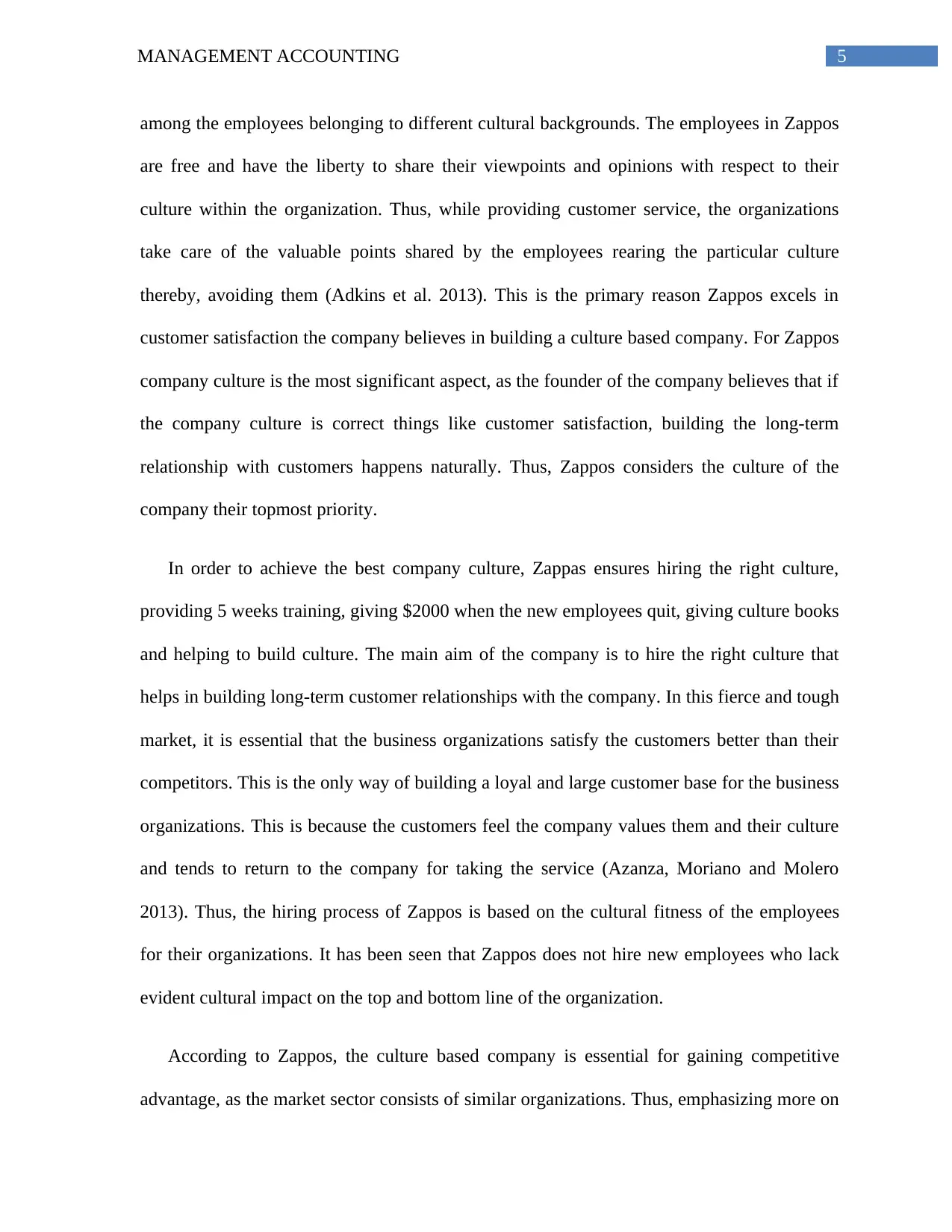
5MANAGEMENT ACCOUNTING
among the employees belonging to different cultural backgrounds. The employees in Zappos
are free and have the liberty to share their viewpoints and opinions with respect to their
culture within the organization. Thus, while providing customer service, the organizations
take care of the valuable points shared by the employees rearing the particular culture
thereby, avoiding them (Adkins et al. 2013). This is the primary reason Zappos excels in
customer satisfaction the company believes in building a culture based company. For Zappos
company culture is the most significant aspect, as the founder of the company believes that if
the company culture is correct things like customer satisfaction, building the long-term
relationship with customers happens naturally. Thus, Zappos considers the culture of the
company their topmost priority.
In order to achieve the best company culture, Zappas ensures hiring the right culture,
providing 5 weeks training, giving $2000 when the new employees quit, giving culture books
and helping to build culture. The main aim of the company is to hire the right culture that
helps in building long-term customer relationships with the company. In this fierce and tough
market, it is essential that the business organizations satisfy the customers better than their
competitors. This is the only way of building a loyal and large customer base for the business
organizations. This is because the customers feel the company values them and their culture
and tends to return to the company for taking the service (Azanza, Moriano and Molero
2013). Thus, the hiring process of Zappos is based on the cultural fitness of the employees
for their organizations. It has been seen that Zappos does not hire new employees who lack
evident cultural impact on the top and bottom line of the organization.
According to Zappos, the culture based company is essential for gaining competitive
advantage, as the market sector consists of similar organizations. Thus, emphasizing more on
among the employees belonging to different cultural backgrounds. The employees in Zappos
are free and have the liberty to share their viewpoints and opinions with respect to their
culture within the organization. Thus, while providing customer service, the organizations
take care of the valuable points shared by the employees rearing the particular culture
thereby, avoiding them (Adkins et al. 2013). This is the primary reason Zappos excels in
customer satisfaction the company believes in building a culture based company. For Zappos
company culture is the most significant aspect, as the founder of the company believes that if
the company culture is correct things like customer satisfaction, building the long-term
relationship with customers happens naturally. Thus, Zappos considers the culture of the
company their topmost priority.
In order to achieve the best company culture, Zappas ensures hiring the right culture,
providing 5 weeks training, giving $2000 when the new employees quit, giving culture books
and helping to build culture. The main aim of the company is to hire the right culture that
helps in building long-term customer relationships with the company. In this fierce and tough
market, it is essential that the business organizations satisfy the customers better than their
competitors. This is the only way of building a loyal and large customer base for the business
organizations. This is because the customers feel the company values them and their culture
and tends to return to the company for taking the service (Azanza, Moriano and Molero
2013). Thus, the hiring process of Zappos is based on the cultural fitness of the employees
for their organizations. It has been seen that Zappos does not hire new employees who lack
evident cultural impact on the top and bottom line of the organization.
According to Zappos, the culture based company is essential for gaining competitive
advantage, as the market sector consists of similar organizations. Thus, emphasizing more on
⊘ This is a preview!⊘
Do you want full access?
Subscribe today to unlock all pages.

Trusted by 1+ million students worldwide

6MANAGEMENT ACCOUNTING
the culture of the company allows Zappos to satisfy the customers and building a strong
customer base. Large customer base maximizes the sales of the company thereby, generating
more revenue and ensuring profit maximization. Having a strong culture allows Zappos to
stand out from its potential competitors in the market along with creating a unique image in
the eye of the customers. As a result, Zappos is able to sustain in the competitive market by
emphasizing and building a strong culture based company.
Conclusion
The e-learning activity concludes and summarizes the activity 2 and activity 3. Activity 2
discusses the significance of organizational culture. The most probable reason due to which the
definition of culture differs are the educational background of the individuals as well as their
knowledge and understanding about cure from individual perspectives. Activity 3 discusses the
significance of culture-based company in achieving customer satisfaction. It has been seen that
Zappos considers culture as their topmost priority that helps them in achieving best customer
satisfaction in the market. Thus, customer satisfaction for Zappos provides an opportunity for the
company to gain the competitive advantage by building the large customer base by considering
their cultures and ethics.
the culture of the company allows Zappos to satisfy the customers and building a strong
customer base. Large customer base maximizes the sales of the company thereby, generating
more revenue and ensuring profit maximization. Having a strong culture allows Zappos to
stand out from its potential competitors in the market along with creating a unique image in
the eye of the customers. As a result, Zappos is able to sustain in the competitive market by
emphasizing and building a strong culture based company.
Conclusion
The e-learning activity concludes and summarizes the activity 2 and activity 3. Activity 2
discusses the significance of organizational culture. The most probable reason due to which the
definition of culture differs are the educational background of the individuals as well as their
knowledge and understanding about cure from individual perspectives. Activity 3 discusses the
significance of culture-based company in achieving customer satisfaction. It has been seen that
Zappos considers culture as their topmost priority that helps them in achieving best customer
satisfaction in the market. Thus, customer satisfaction for Zappos provides an opportunity for the
company to gain the competitive advantage by building the large customer base by considering
their cultures and ethics.
Paraphrase This Document
Need a fresh take? Get an instant paraphrase of this document with our AI Paraphraser
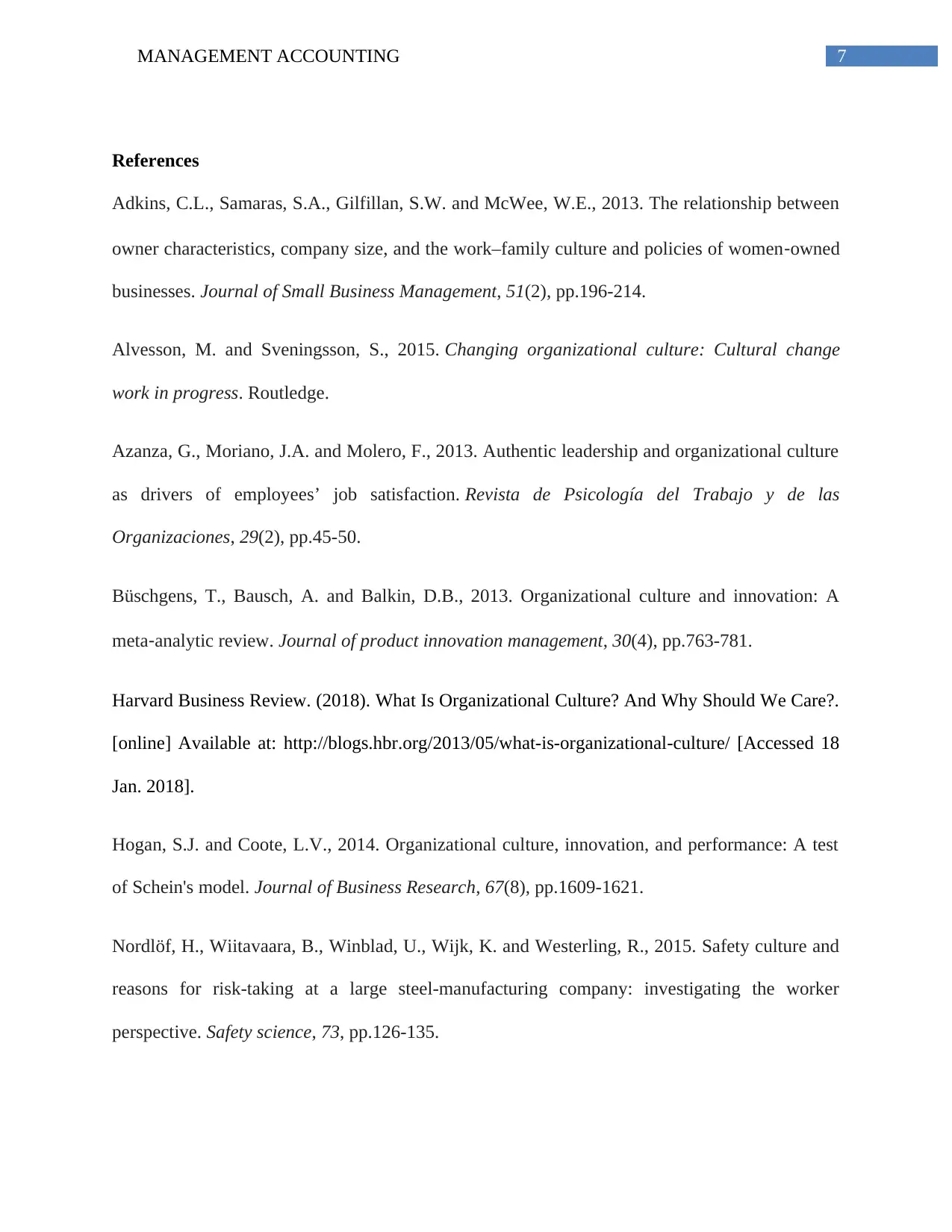
7MANAGEMENT ACCOUNTING
References
Adkins, C.L., Samaras, S.A., Gilfillan, S.W. and McWee, W.E., 2013. The relationship between
owner characteristics, company size, and the work–family culture and policies of women‐owned
businesses. Journal of Small Business Management, 51(2), pp.196-214.
Alvesson, M. and Sveningsson, S., 2015. Changing organizational culture: Cultural change
work in progress. Routledge.
Azanza, G., Moriano, J.A. and Molero, F., 2013. Authentic leadership and organizational culture
as drivers of employees’ job satisfaction. Revista de Psicología del Trabajo y de las
Organizaciones, 29(2), pp.45-50.
Büschgens, T., Bausch, A. and Balkin, D.B., 2013. Organizational culture and innovation: A
meta‐analytic review. Journal of product innovation management, 30(4), pp.763-781.
Harvard Business Review. (2018). What Is Organizational Culture? And Why Should We Care?.
[online] Available at: http://blogs.hbr.org/2013/05/what-is-organizational-culture/ [Accessed 18
Jan. 2018].
Hogan, S.J. and Coote, L.V., 2014. Organizational culture, innovation, and performance: A test
of Schein's model. Journal of Business Research, 67(8), pp.1609-1621.
Nordlöf, H., Wiitavaara, B., Winblad, U., Wijk, K. and Westerling, R., 2015. Safety culture and
reasons for risk-taking at a large steel-manufacturing company: investigating the worker
perspective. Safety science, 73, pp.126-135.
References
Adkins, C.L., Samaras, S.A., Gilfillan, S.W. and McWee, W.E., 2013. The relationship between
owner characteristics, company size, and the work–family culture and policies of women‐owned
businesses. Journal of Small Business Management, 51(2), pp.196-214.
Alvesson, M. and Sveningsson, S., 2015. Changing organizational culture: Cultural change
work in progress. Routledge.
Azanza, G., Moriano, J.A. and Molero, F., 2013. Authentic leadership and organizational culture
as drivers of employees’ job satisfaction. Revista de Psicología del Trabajo y de las
Organizaciones, 29(2), pp.45-50.
Büschgens, T., Bausch, A. and Balkin, D.B., 2013. Organizational culture and innovation: A
meta‐analytic review. Journal of product innovation management, 30(4), pp.763-781.
Harvard Business Review. (2018). What Is Organizational Culture? And Why Should We Care?.
[online] Available at: http://blogs.hbr.org/2013/05/what-is-organizational-culture/ [Accessed 18
Jan. 2018].
Hogan, S.J. and Coote, L.V., 2014. Organizational culture, innovation, and performance: A test
of Schein's model. Journal of Business Research, 67(8), pp.1609-1621.
Nordlöf, H., Wiitavaara, B., Winblad, U., Wijk, K. and Westerling, R., 2015. Safety culture and
reasons for risk-taking at a large steel-manufacturing company: investigating the worker
perspective. Safety science, 73, pp.126-135.

8MANAGEMENT ACCOUNTING
YouTube. (2018). Zappos CEO Tony Hsieh talks about building a culture-based company.
[online] Available at: http://www.youtube.com/watch?v=JdKZapHZL4c [Accessed 18 Jan.
2018].
YouTube. (2018). Zappos CEO Tony Hsieh talks about building a culture-based company.
[online] Available at: http://www.youtube.com/watch?v=JdKZapHZL4c [Accessed 18 Jan.
2018].
⊘ This is a preview!⊘
Do you want full access?
Subscribe today to unlock all pages.

Trusted by 1+ million students worldwide
1 out of 9
Related Documents
Your All-in-One AI-Powered Toolkit for Academic Success.
+13062052269
info@desklib.com
Available 24*7 on WhatsApp / Email
![[object Object]](/_next/static/media/star-bottom.7253800d.svg)
Unlock your academic potential
Copyright © 2020–2025 A2Z Services. All Rights Reserved. Developed and managed by ZUCOL.





